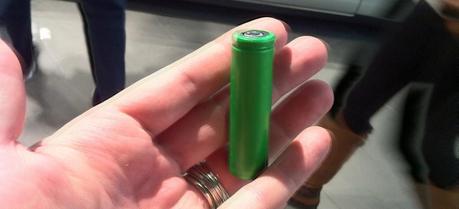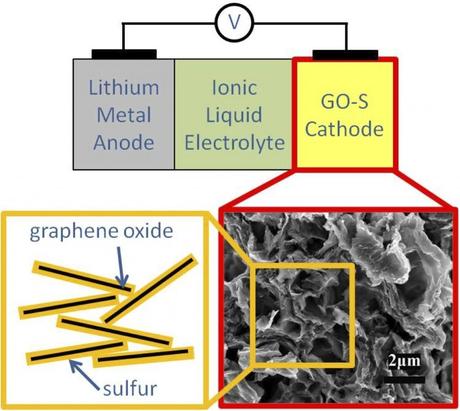 (Credit: Flickr @ Wesley Fryer http://www.flickr.com/photos/wfryer/)
(Credit: Flickr @ Wesley Fryer http://www.flickr.com/photos/wfryer/)
Researchers at the U.S. Department of Energy’s Lawrence Berkeley National Laboratory (Berkeley Lab) have created a new lithium-sulfur battery prototype that outperforms other lithium-sulfur cells by more than two times in terms of energy capacity. This battery can last for more than 1,500 cycles of charge-discharge with minimal decay, which is the longest cycle life reported so far for any lithium-sulfur battery.

A schematic of a lithium-sulfur battery with SEM photo of silicon-graphene oxide material. (Credit: Berkeley Lab). Click to enlarge.
Demand for high-performance batteries for electric and hybrid electric vehicles capable of matching the range and power of the combustion engine encourages scientists to develop new battery chemistries that could deliver more power and energy than lithium-ion batteries, currently the best performing battery chemistry in the marketplace.
For electric vehicles to have a 300-mile range, the battery should provide a cell-level specific energy of 350 to 400 Watt-hours/kilogram (W·h/kg). This would require almost double the specific energy (about 200 W·h/kg) of current lithium-ion batteries. The batteries would also need to have at least 1,000, and preferably 1,500 charge-discharge cycles without showing a noticeable power or energy storage capacity loss.
“Our cells may provide a substantial opportunity for the development of zero-emission vehicles with a driving range similar to that of gasoline vehicles,” says Elton Cairns, of the Environmental Energy Technologies Division (EETD) at Berkeley Lab.
The battery initially showed an estimated cell-specific energy of more than 500 W·h/kg and it maintained it at >300 W·h/kg after 1,000 cycles—much higher than that of currently available lithium-ion cells.
The team is now seeking support for the continuing development of the lithium-sulfur cell, including higher sulfur utilization, operation under extreme conditions, and scale-up. Partnerships with industry are being sought. The next steps in the development are to further increase the cell energy density, improve cell performance under extreme conditions, and scale up to larger lithium-sulfur cells.
Song M.K., Zhang Y., & Cairns E.J. (2013). A Long-Life, High-Rate Lithium/Sulfur Cell: A Multifaceted Approach to Enhancing Cell Performance. Nano Letters PMID: 24219588

posted on 04 December at 13:03
samozřejmě, že lze vyvinout mnohem lepší baterie, než LiFePO4. Jen je potřeba povolit elektromobilitu. www.elektromobily-os.cz